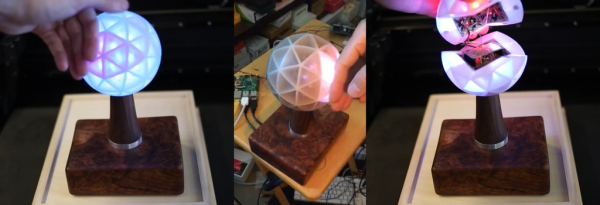[Jonathan Foote] made a really cool device: the Ommatid spherical display and controller. Part woodworking craft project, part art, and part tremendous hack, the Ommatid is something that we don’t really have a name for. But you can watch it in action, running demo code, in a video below the break.
The sphere design started out with a “20-sided regular polyhedron” with which D&D players should be familiar, and then divided each triangular face into four more triangles. An 80-sided die? Almost. One triangle’s worth was sacrificed for the part that mounts to the base.
Each facet contains an RGB LED and an IR sensor so that it can tell when a hand is nearby. All of this input and output is run through a Raspberry Pi, so both the sensing and display interactions are easily modified. [Jonathan] runs us through the electronics, programming, and interactivity in a separate Instructable. We really like [Jonathan]’s idea of turning this device into an OSC controller / display.





 Wanting to send a message to at least a few people in China, the members of the hackerspace had to think laterally. Metalab member [amir] came up with a way to encode data that could be printed on t-shirts. These bright, colorful squares featured in all of the interviews with Metalab members carried messages like, “free tibet!”, “remember tian’anmen 1989” and “question the government. dont trust the propaganda”
Wanting to send a message to at least a few people in China, the members of the hackerspace had to think laterally. Metalab member [amir] came up with a way to encode data that could be printed on t-shirts. These bright, colorful squares featured in all of the interviews with Metalab members carried messages like, “free tibet!”, “remember tian’anmen 1989” and “question the government. dont trust the propaganda”











